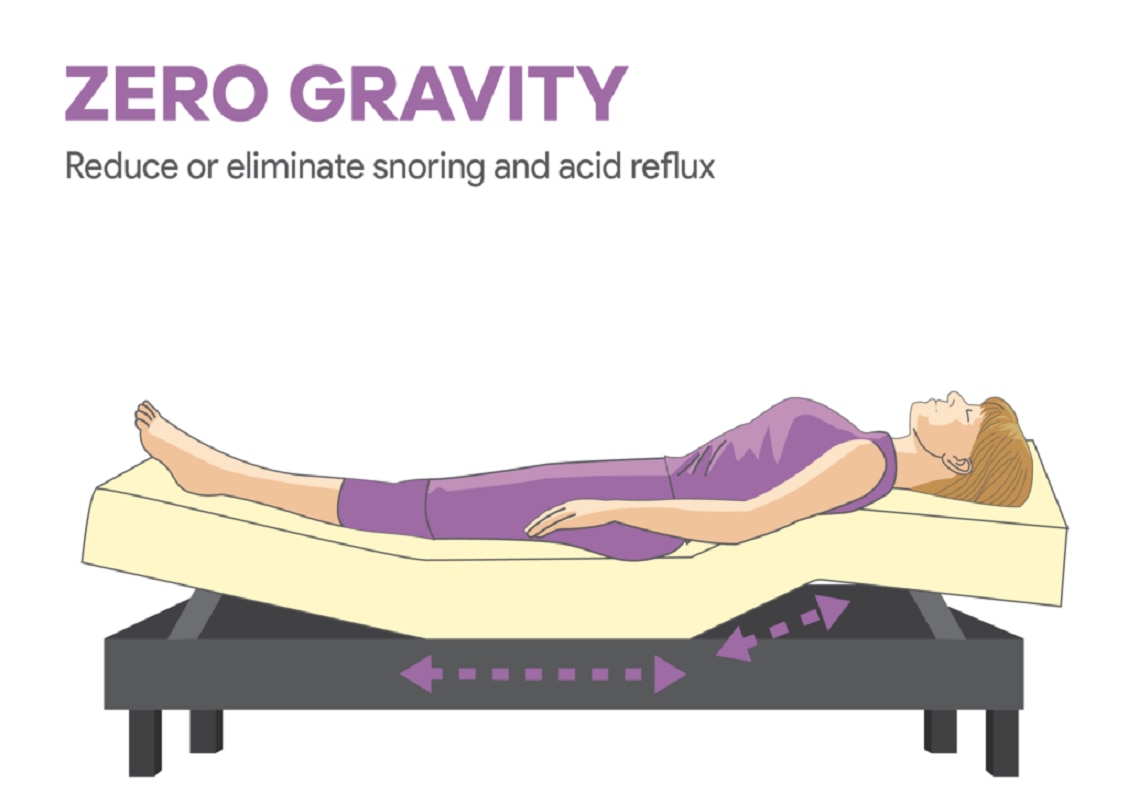Living in a fast-paced world where we constantly need to be active and productive, it is expedient to carve out quality time to rest. Adjustable beds are a good and new way of helping you get that much-needed rest, whether you’re feeling sleepy or not.
Sometimes, you stay in bed to rest, read, eat, watch movies, or even work, and in each of these instances, there is a need to keep the body comfortable and well-supported.
Using an adjustable bed, you can control how your bed base holds up the bed, improving your sleep quality.
Different Positions of an Adjustable Bed
1) Zero Gravity Position

In this position, the body is placed in a neutral sleeping position. Here, it’s quite easy to fall asleep as the body stays comfortable with the head raised and the knees slightly lifted. The arrangement also provides support for the heart, spine, and nervous system.
When sleeping in the zero-gravity position, you shouldn’t make use of a pillow to avoid altering the angle of the bed base and if you are the type to use a pillow, use a flat one. This arrangement is better for back sleepers, and it works wonders for people in these conditions:
● Pregnancy: Lots of women experience sleeping disorders and swollen feet when pregnant. And sleeping in this position helps to increase blood circulation and lower stress levels, thus improving sleep quality.
● Arthritis: This is a condition that causes painful inflammation and stiffness of the joints. Usually, arthritis flares up at night when lying down, causing the inflammatory chemicals to pool in the liquid that cushions the joints. This is relieved when sleeping in the zero-gravity position as the knees are slightly bent, reducing pressure and preventing the chemicals from pooling at the joints.
● Asthma: In this neutral position, the head is elevated, and it keeps the airways free from obstruction and any form of interference.
2) Head Up Position
The head-up position simply refers to the arrangement where the head of the bed base is lifted at some angles to provide more support and lift for your head. This position is perfect for people who struggle with snoring, acid reflux, or sleep apnea, as it prevents the collapse of the airways.
● Snoring: This is the hoarse or harsh sound that comes from the mouth or nose when breathing is partially hindered, and this disrupts sleep quality and leads to daytime fatigue and irritation.
When sleeping in a head-up position, pressure is reduced on the airways, allowing for easier air passage. To gain maximum benefit from this sleeping arrangement, raise your bed base to lift both your head and shoulders to a 20-30 degrees angle.
● Acid reflux: occurs when the stomach acid flows back into the oesophagus and irritates its lining. It usually manifests as a burning sensation in the chest after a meal or while lying down.
In a lying position, the stomach and the throat are on the same level, but by elevating the head above the stomach level, gravity comes into play to keep your stomach contents down.
● Obstructive sleep apnea: is a sleep disorder in which breathing repeatedly stops and starts at night. This disorder causes the person to snore loudly and wake up tired.
The condition occurs when throat muscles relax and block the airways during sleep, causing the brain to wake the person. Sleeping in a head-up position opens up the airways and allows for more quality sleep.
● Asthma: In this condition, the airway gets narrow and swollen and is usually blocked by excess mucus, causing breathing difficulties. Sleeping in a way to elevate your head region above the rest of your body helps gravity drain the sinuses and keep them fluid-free.
3) Flat position
When sleeping in this position, you leave your bed frame straight or flat, with no adjustments for height. Some people find it difficult to enjoy sleep this way, but it is best for people with:
● Back pain: People who experience back pain are advised to sleep on a flat bed with a sturdy frame. This way, they can balance out the pressure on all parts of the body and remove the extra pressure from the back.
To adapt to the spine’s natural curve, you can put a pillow under your knees to give it a little lift; ensure not to use a pillow that’s too high.
● Shoulder pain: Lie down flat on your bed to even out the pressure on your shoulders, and for more comfort, put a padded blanket under your armpit area.
4) Feet Up Position
Sitting or sleeping with the feet up has been known to ease lower back and leg pain. Sleeping in this position can help ease these conditions:
● Sciatica: This is an irritation or compression of a nerve in the lower back, and it can be remedied by sleeping with your feet up to reduce pressure on the joints behind the spine.
● Leg swelling: Sleeping with your feet up helps to drain the leg of fluid that could cause swelling.
Final Thoughts
It is important to know that various body types, illnesses or conditions might require you to assume different sleeping positions. And you can experiment with different types using the Flexispot adjustable bed base to know what works for you and gives you maximum comfort.
